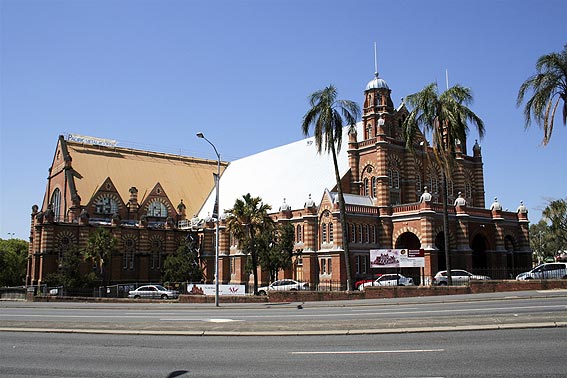
Old Museum Building (formerly Exhibition Building), Bowen Hills
[Photograph by Trevor Bunning (October 2007)]

Old Museum Building (formerly Exhibition Building), Bowen Hills
[Photograph by Trevor Bunning (October 2007)]
Historical and Technical Documentation by Geoffrey Cox
© OHTA 2007, 2011, 2013 (last updated May 2013)
This building, originally the property of the Queensland National Association and known as the 'Exhibition Building', was built in 1891 to replace an earlier timber building destroyed by fire in 1888. Land at the junction of Gregory Terrace and Bowen Bridge Road had been leased in 1875 to the Queensland National Agricultural and Industrial Association as an exhibition ground, and the earlier building was opened in August 1876 for the first Queensland Intercolonial Exhibition.1
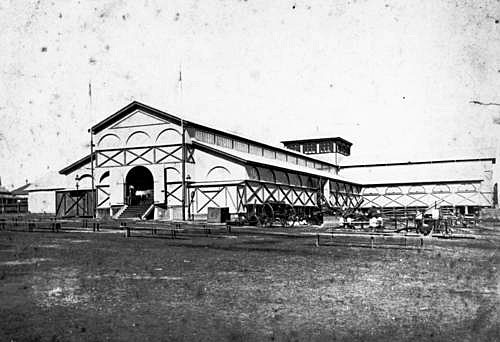
Brisbane's First Exhibition Building, opened in August 1876
[Photograph: John Oxley Library, State Library of Queensland]
The foundation stone of the present building was laid on 25 April 1891, and it was completed by August that year. Built in Romanesque style to the design of the Brisbane architect, G.H.M. Addison, of the partnership Oakden, Addison and Kemp, it features twin cupolas and banded polychrome brickwork. A concert hall was incorporated into the design of the building from the outset.2 More recently, the building housed the Queensland Art Gallery and Museum, until they moved to the Queensland Cultural Centre on the South Bank of the Brisbane River in 1986.
First Organ.
From 1892 this building housed the organ built by Henry Willis & Sons, London, that is now in the Brisbane City Hall. Originally the property of the Queensland National Association, the instrument was purchased by the Brisbane City Council in 1900, and remained at the Exhibition Building until 1927, when it was removed for rebuiling, enlargment and installation in its present location.3
Present Organ.
The early history of the present organ remains obscure. It served in St Stephen's Cathedral, Brisbane, between 1921 and 1988, and is known to have originated in Melbourne. Mr Joe Whitehouse (Jnr) recalled that it was stored in a shed in Melbourne prior to its removal to Brisbane.4 In other accounts emanating from the Whitehouse firm, the organ was reported to have been built by an English builder whose name could not be recalled, and erected in the factory of an organ builder whose name they believed to be Taylor.5 This was presumably Frederick Taylor of Melbourne, who had been apprenticed to George Fincham in 1875 and began business on his own account in 1900.6
In yet another account emanating from Miss Kitty Slack, who was organist at St Stephen's Cathedral, 1923-73, the organ is attributed to the Melbourne builder, William Anderson, and thought to have been built c.1890. It was reportedly stored at the Strand Theatre in Brisbane from 1916 or earlier. The details she recorded were as follows:
This instrument was built in Melbourne by the firm Anderson Organ Builders, probably in the year 1890. The late Mr. Whitehouse, founder of the firm Whitehouse Brothers of Red Hill, Brisbane, was instructed by Mr. Dan Carroll, of Birch and Carroll, to go to Melbourne, dismantle and pack the organ for delivery to Brisbane. The idea then was to install it in the Strand Theatre [Queen Street].
On arrival, the instrument was stored in the basement of the theatre for some time, and after advice from Mr. J. H. Whitehouse that it was not suitable for theatre use, owing to the fact it was designed for church use, the organ was then put up for sale. It was purchased by the Cathedral, according to the records, in the year 1920.
When installed, extra stops were added to the Swell Organ and Pedals. The organ was blessed and opened by the late Archbishop Duhig, May 1921, Pentecost Sunday.7
The additions to the Swell and Pedal Organs appear in fact to have taken place a few years apart. The additional Swell stops (Flute 4ft and Vox Humana 8ft) were suspended inside the Swell box on pneumatic action, and are presumed to have been added around the time of installation in 1921. There is no mention of them in the Whitehouse Bros Ledger (1922-1940), whereas the Pedal additions ('Large Open Diapason' and 'Pedal Octave Coupler') date from 1925. Regular tuning is recorded from at least September 1922.8 The organ occupied the southern side of the rear gallery, which had been considerably enlarged to accommodate it.9
When the organ was installed in St Stephen's Cathedral in 1921, the music there was under the direction of Leonard Francis, and Lilian Clancy was the organist. For the opening of the organ on Pentecost Sunday, the choir sang an Ecce sacredos magnus by John Wiegand, the Jubilee Mass of Paolo Giorza, together with the Introit, Gradual and Communion by A. E. Tozer. In the afternoon they sang the Gloria from the 'Twelfth Mass' of Mozart, Laudate pueri Dominum by Nicola Zingarelli, and an Ave Maria by Alexandre Guilmant.10
From the time of its installation in 1921 until the early 1970s, the organ remained under the care of Whitehouse Bros. No major alterations were undertaken during this period, though there were routine overhauls in August 1939 and December 1953.11
In 1974, however, significant alterations were proposed by Dr Robert Huestis, one of the organists associated with St Stephen's at that time.12 The Choir Dulciana 8ft was exchanged in 1978 for a five-rank manual chest from Whitehouse Bros, with which Huestis intended to enlarge the Pedal division. Other alterations made by Heustis during the 1970s included the addition of a second-hand Principal 2ft on the Dulciana slide, the removal of the swell shutters, and attempts to sell the three Swell and Pedal stops that had been added in the 1920s.
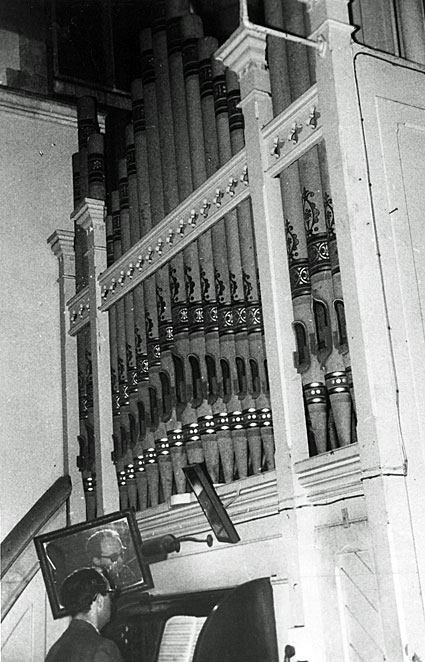
Dr Robert Huestis at the console in St Stephen's Cathedral
[Photograph by Geoffrey Cox (c.1974)]
By the end of the 1970s, the intrinsic worth of the organ was understood differently, and quotations to restore the instrument were sought from the South Island Organ Company of Timaru, New Zealand.13 The project lost momentum, however, and it was not until 1983 that the instrument was eventually restored by Messrs Brown & Arkley of Sydney, with Mr David Kinsela as consultant.14

The Anderson organ, apparently at the time of the 1983 restoration
[Photograph: The Courier-Mail (29 June 1990)]
It is known that some of Anderson's instruments were secondhand, and that he sometimes enlarged existing instruments without leaving his name-plate on them.15 During the late 1970s and early 1980s, it became apparent that the four-stop unenclosed Choir Organ at St Stephen's had been added to what appeared originally to have been a two-manual organ. The Choir Organ was placed behind the swell box in the position presumably occupied originally by the Pedal Organ. The original depth of the case (comprising a pine frame and redwood panels), painted white, was probably only some 11 feet, and the compass of the Choir chest was originally 54 notes rather than 56 notes. The Choir Organ appears, therefore, to derive from an earlier instrument. A third keyboard has been added to the console (with noticeably different drawstops), as well as a distinctive roll-top between polished pine wing-boards. The radiating-concave pedalboard appears to have replaced an earlier straight one, and there is still evidence of mechanical composition pedals that have been adapted to operate from the pneumatic pistons to the Swell and Great.16

Anderson's three-manual console
[Photograph by Trevor Bunning (October 2007)]
The attribution of the organ in its three-manual configuration to William Anderson of Melbourne is supported by the high degree of similarity between the console at the Old Museum / St Stephen's (c.1890?) and that at Holy Trinity Anglican Church, Williamstown, Victoria (1896), for which Anderson was also responsible. The chamfered edges to the stop jambs and scrolled key cheeks are almost identical.17
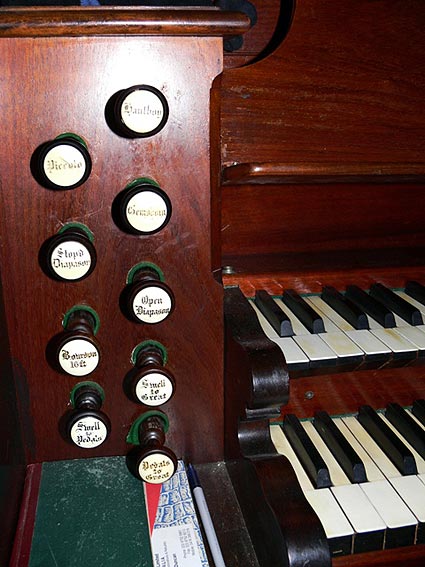
|
| Anglican Church, Williamstown (1896) [Photograph by John Maidment (August 2007)] |
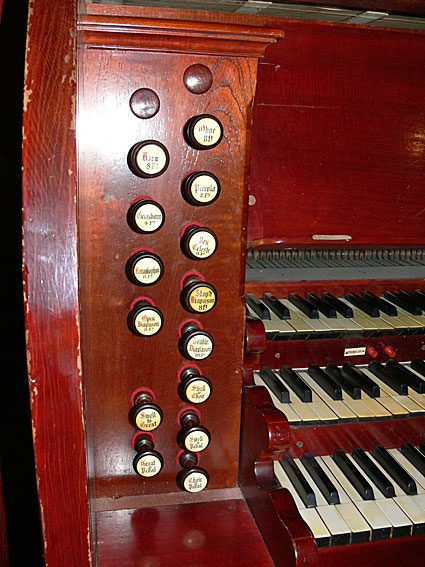
|
- formerly at St Stephen's Cathedral (c.1890?) [Photograph by John Maidment (October 2007)] |
By a process of elimination, John Maidment has proposed that the organ now at the Old Museum (formerly at St Stephen's Cathedral) originated at St Mary's Catholic Church, West Melbourne, where a new organ was opened in August 1889. Although Anderson was not named as the builder in any of the surviving records, he had an earlier association with this church. The organ may have remained in the old church at West Melbourne for some time after the new church was opened there in 1900, and Anderson could conceivably later have added the Choir division (which has a 54-note chest) from the four-stop organ that he replaced in 1896 at Holy Trinity Anglican Church, Williamstown, Vic.18
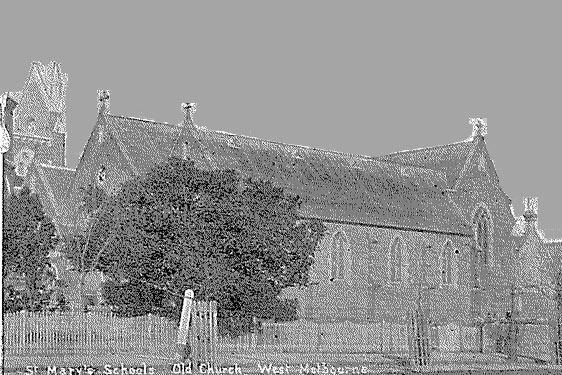
Old St Mary's Catholic Church, West Melbourne, early 1900s
[Photograph from Some of the Fruits of Fifty Years: Ecclesiastical Annals (1905)]
John Maidment further notes several Fincham traits: First, the use of circular caps soldered onto the resonators of the Great Trumpet 8ft (see below) was a Fincham attribute, suggesting that the Fincham firm may have made these pipes. Secondly, the Swell box has vertical screwed-on wooden panels on either side of the horizontal shutters – another Fincham trait. Finally, the zinc façade pipes, especially the central pipe of each flat with their 'ogee' mouths, are said to be typical of Fincham.19
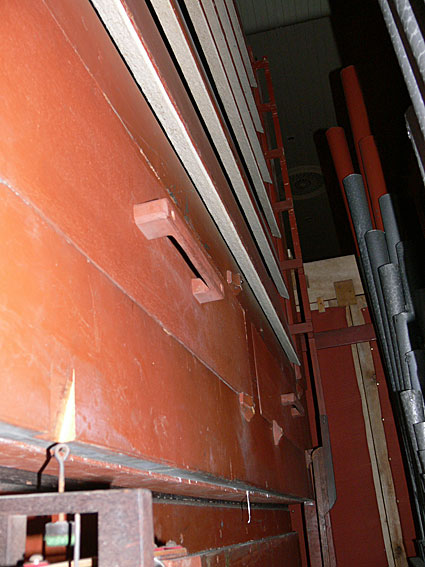
Horizontal swell shutters
[Photograph by John Maidment (October 2007)]
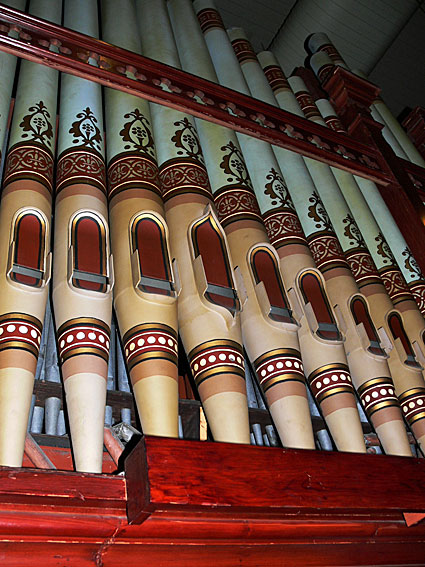

'Ogee' mouths on the central pipes of each flat
[Photographs by John Maidment (October 2007)]
It would seem, therefore, that Fincham may have been responsible for much, if not all, of the Great and Swell Organs, and that Anderson simply added the older Choir Organ and enlarged and rebuilt the console. It is interesting also that there seem to have been proposals late in 1913 to install the 'Anderson' organ in a picture theatre in Melbourne, and that it apparently remained in Melbourne at least until this time.20 This provides a probable link to the fact that the Brisbane organ was stored initially at the Strand Theatre in Queen Street, and the concordant dates of the respective Brisbane and Melbourne accounts clearly support Maidment's hypothesis.
Work undertaken as part of the 1983 restoration included the following:
• removal of the two c.1921 Swell stops (not 1925, as described by Kinsela), which were reported to have been placed in storage inside the organ,
• replacement of the missing Choir Dulciana (using a former Celeste by Roberts),
• addition of a Pedal Trombone 16ft (made by Australian Pipe Organs),
• electrification of the pedal action, and discarding of the 1925 pedal octave coupler,
• retention of cone tuning on all but the smallest Mixture pipes, and the pitch slightly higher than concert pitch,
• removal of circular caps soldered onto the resonators of the Great Trumpet,
• removal of the white paint on the case, and repainting of the diapering on the 19 case pipes.21
In conjunction with major architectural renovations in the Cathedral during the late 1980s, the former organ gallery was removed and the organ was placed in storage in 1988. It was purchased in 1990 by the Queensland Government for the Queensland Youth Orchestra, who had by this stage found a new home in the old Exhibition Building (former Queensland Museum),22 although it was not installed in its present location until 1998.

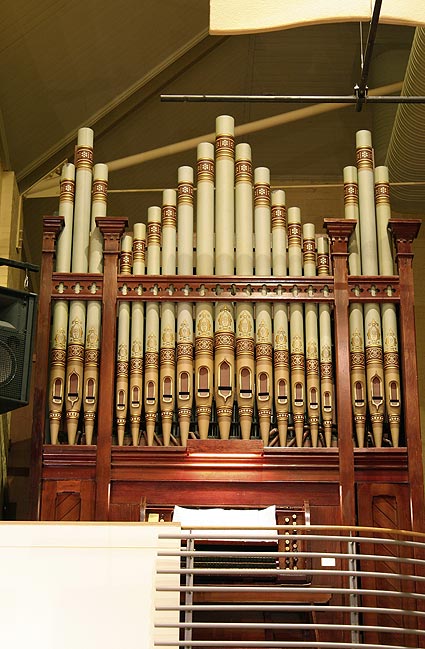
The organ in its new location in the Old Museum complex
[Photographs by Trevor Bunning (October 2007)]
The specification, based on nomenclature noted in the 1970s and earlier, was as follows:
| GREAT Double Diapason Open Diapason Gamba Clarabella Principal Flute Twelfth Fifteenth Mixture Trumpet SWELL Double Diapason Open Diapason Stopped Diapason Keraulophon Vox Celeste Gemshorn Piccolo Cornopean Oboe [Flute] [Vox Humana] CHOIR [unenclosed] Dulciana Gedact Flute Clarionet PEDAL Open Diapason Open Bourdon Principal Trombone COUPLERS Swell to Great Swell to Choir Swell to Pedal Great to Pedal Choir to Pedal [Pedal] Octave |
16 8 8 8 4 4 2-2/3 2 III 8 16 8 8 8 8 4 2 8 8 [4] [8] 8 8 4 8 16 16 16 8 16 |
[marked 8ft] [marked 2-3/4ft] [includes tierce] [now marked 'Stop'd Diapason'] [gvd bass] [Tenor C] [wood] [now marked 'Horn'] [originally marked 8'] [c.1921, in storage until 1983] [c.1921, in storage until 1983] [gvd bass] [removed 1978; replaced 1983] [harmonic] [wood] [1925; removed 1983] [1983] [1925; removed 1983] |
Compass: 56/30 [Choir originally 54-note chest]
Mechanical action (manuals)
Electro-pneumatic action (pedals) [tubular pneumatic until 1983]
Draw-stop console
Trigger swell lever
Radiating concave pedalboard
Tremulant [general]
3 pistons to Great [pneumatic]
3 pistons to Swell [pneumatic]
Compass: 56/30 [Choir originally 54-note chest]23


The stop jambs of the Anderson organ
showing black-faced stop knobs for the added Choir division,
and stop tabs for later additions
[Photographs by John Maidment (October 2007)]
In the process of installing the organ in its new location in 1998, further details came to light, which are recorded here. The work was carried out by W.J. Simon Pierce of Brisbane, who also undertook necessary repairs following the ten-year period of storage. Owing to the fatigued condition in which much of the pipework was found, tuning slides were fitted throughout, and the pitch of the organ was set at approximately A.444. The Swell Cornopean 8ft appears to have been renamed 'Horn' at this or an earlier time, and the spelling and nomenclature of various Choir and Pedal stops appear also to have been changed. The two former Swell stops, said to have been stored inside the organ in 1983, had apparently disappeared.24
Apart from the various changes and additions noted above, all of the pipework appeared to be integral to the original organ, except that the pipes of the Swell Cornopean 8ft [renamed 'Horn'] were observed to be marked 'Swell Clarion' from Tenor C upwards, and did not fit correctly into the original rack-board.25 Simon Pierce has suggested from the layout of the Choir Organ that this division may once have been enclosed.26
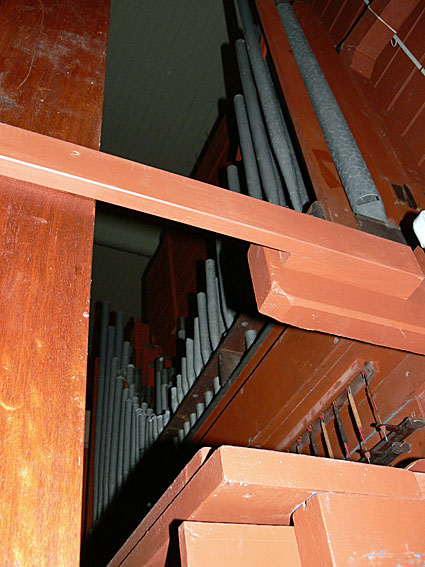
Pipework of the Choir Organ,
showing the Clarionet 8ft at the front of the windchest
[Photograph by John Maidment (October 2007)]
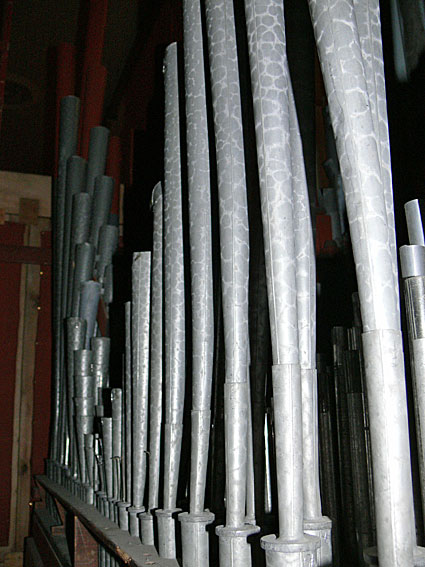
Pipes of the Great Trumpet 8ft
[Photograph by John Maidment (October 2007)]
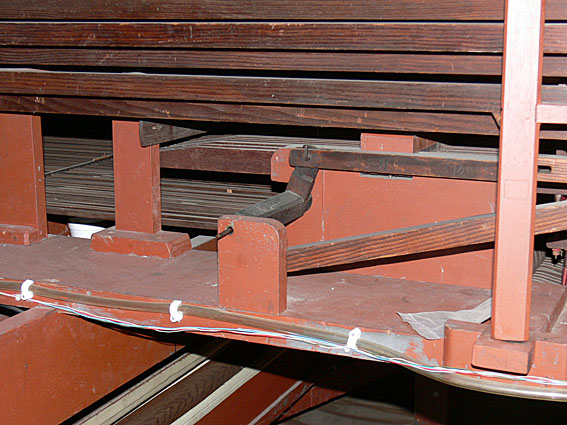
Stop Action, Trackers & Bellows
[Photograph by John Maidment (October 2007)]
__________________________________________________________________________
1 Queensland Heritage Council, Queensland Heritage Register, location 600209.
2 Queensland Heritage Council, op.cit; Donald Watson & Judith McKay, Queensland Architects of the 19th Century: A Biographical Dictionary (Brisbane: Queensland Museum, 1994), pp. 5-6, 135-36.
3 Geoffrey Cox, 'The Willis Organ at the Exhibition Concert Hall in Brisbane: The Finest in the City,' OHTA News, vol. 34, no. 4 (October 2010), pp. 17-28.
4 Personal communication to G. Cox from Mr J. H. Whitehouse (Jnr), January 1973.
5 Letter dated 7 April 1967 from Whitehouse Bros to Miss Kitty Slack (organist at St Stephen's Cathedral, 1923-1973), in the Catholic Archives, St Stephen's Cathedral, Brisbane. See also: Veronica Corkeron, 'The St Stephen's Cathedral Pipe Organ.' (Postgraduate Diploma Thesis, Queensland Conservatorium of Music, 1988).
6 Enid N. Matthews, Colonial Organs and Organbuilders (Carlton: Melbourne University Press, 1969), pp. 87ff.
7 [Kitty Slack] 'St Stephen's Cathedral Brisbane Pipe Organ: History of the Organ' (unpublished MS, compiled c.1973) - copy in the Catholic Archives, St Stephen's Cathedral, Brisbane; Personal communication to G. Cox from Miss Kitty Slack, 1973.
8 Whitehouse Bros Ledger (1922-1940), p. 151. The date of the ledger entry is difficult to determine - between June 1923 and 1926, but the date 1925 is confirmed by letters in the Catholic Archives, St Stephen's Cathedral, Brisbane.
9 Personal communication to G. Cox from Miss Kitty Slack, September 1974.
10 The Brisbane Courier (16 May 1921), p. 8; The Age (21 May 1921), pp. 4-5; Programme for Pentecost Sunday, 1921 (Brisbane Archdiocesan Archives) - cited in N. Byrne, op. cit., pp. 15-16.
11 Whitehouse Bros Ledger (1922-1940), p. 151; Whitehouse Bros Ledger (1940-1954), p. 281.
12 'Proposed Specification for St Stephen's Organ, 4 May 1974,' supplied to G. Cox by Robert Huestis, 1974.
13 Personal communication to G. Cox from David Molloy (organist at St Stephen's Cathedral, 1977-79), August 2007.
14 The Sunday Mail (27 February 1983), p. 5; The Courier Mail (8 August 1984), p. 22.
15 Matthews, op. cit., pp. 3, 24-25.
16 David Kinsela, 'St Stephen's Cathedral, Brisbane: A monument of Victorian organbuilding revitalized,' OHTA News, vol. 8, no. 3 (July 1984), pp. 4-7; Personal communication to G. Cox from David Molloy (organist at St Stephen's Cathedral, 1977-79), August 2007.
17 John Maidment, 'William Anderson -19th Century Melbourne Organ Builder - An Overview,' OHTA News, vol. 32, no. 1 (January 2008), p. 18. This article originated as a paper delivered at the 30th Annual Conference of OHTA, Brisbane, on 1 October 2007.
18 John Maidment, op. cit, pp. 16-17.
19 Maidment, op. cit., p. 16.
20 Maidment, op. cit., p. 17.
21 Kinsela, op. cit.
22 The Courier Mail (29 June 1990), p. 9.
23 Specification noted by G. Cox, January 1973, at St Stephen's Cathedral [details confirmed by David Molloy, 2007], incorporating subsequent changes.
24 Timothy McEwen, 'Installation of the organ in the old Museum Building,' The Organ Voice, vol. 24, no. 2 (June 1998), p. 7.
25 Kinsela, op. cit., p. 5; McEwen, op. cit., p. 9.
26 McEwen, op. cit., p. 9.